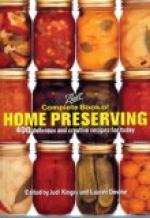Table linen, like friendship, must be kept constantly in repair. Look out for the thin places and darn before they have a chance to wear through. Ravelings from the cloth should be kept for this purpose. A carefully applied patch or darn is scarcely noticeable after laundering. The hardest wear comes where the cloth hangs over the edge of the table, at head and foot. When it begins to be thin at these places cut off one end at the worn point, if the cloth is sufficiently long to warrant it, and hem the raw edge. This draws the other worn place well up on the table where the friction is much less, considerably lengthening the life of the cloth. The cut-off end may be converted into fringed napkins, on which to lay croquettes, fried potatoes, etc., doilies for bread and cake plates, children’s napkins, or tray covers. Old table linen passes through several stages of decline before it becomes absolutely useless; when too much worn for table purposes it enwraps our bread and cake and strains our jellies, and when at last it has won the well-earned rest of age, it still waits in neat rolls to bandage our cuts and bruises.
HOW TO LAUNDER
There is a saying that “Old linen whitens best,” to which we might also add that it looks best, gaining additional smoothness and gloss with each laundering. Table linen should never dry on the line, but be brought in while still damp, very carefully folded, and ironed bone-dry, with abundant “elbowgrease.” This is the only way to give it a “satin gloss.” Never use starch. The pieces should be folded evenly and carefully, with but one crease—down the middle—and not checker-boarded with dozens of lines. Centers and large doilies are best disposed of by rolling over a round stick well padded.
TABLE PADS
Much wear and tear on both table and cloth is prevented by the use of a double-faced Canton-flannel pad, which prevents the cloth from cutting through on the edges, gives it body, softens the clatter of the dishes, and absorbs liquids. It comes in 1 1/2- and 1 3/4-yard widths and sells for 65 to 85 cents a yard. Pads of asbestos are also used, but are far more expensive. It is a good plan to have two if possible—one for use on the everyday table, and a longer one to cover the family-gathering table. Covers for the sideboard and any small table used in the dining room are of hemstitched or scalloped linen, either plain or embroidered—never ruffled or fluffy.




